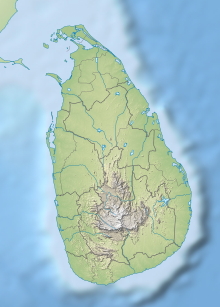Horton Plains National Park
| Horton Plains National Park | |
|---|---|
| හෝර්ටන් තැන්න ජාතික උද්යානය | |
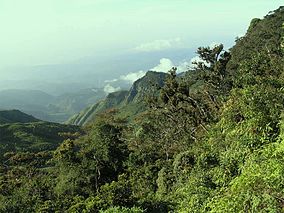 World's End, a sheer precipice within the park | |
| Location | Central province, Sri Lanka |
| Nearest city | Ohiya and Nuwara Eliya |
| Coordinates | 6°48′N 80°48′E / 6.800°N 80.800°E |
| Area | 3,160 ha (12.2 sq mi) |
| Established | 1969 (Nature reserve) 1988 (National park) |
| Governing body | Department of Wildlife Conservation |
| World Heritage site | 2010 (within the site Central Highlands of Sri Lanka)[1] |
| UNESCO World Heritage Site | |
|---|---|
| Criteria | Natural: ix, x |
| Reference | 1203 |
| Inscription | 2010 (34th Session) |
| Area | 56,844 ha |
| Buffer zone | 72,645 ha |
Horton Plains National Park (Sinhala: හෝර්ටන් තැන්න ජාතික උද්යානය, romanized: Hortan Thanna Jathika Udyanaya) is a national park in the central highlands of Sri Lanka that was designated in 1988. It is located at an elevation of 2,100–2,300 m (6,900–7,500 ft) and encompasses montane grassland and cloud forest. It is rich in biodiversity and many species found here are endemic to the region. It is also a popular tourist destination and is situated 8 kilometres (5.0 mi) from Ohiya, 6 kilometres (3.7 mi) from the world-famous Ohiya Gap/Dondra Watch and 32 kilometres (20 mi) from Nuwara Eliya.
The Horton Plains are the
The sheer precipice of World's End and Baker's Falls are among the tourist attractions of the park.
Physical features

Horton Plains is located on the southern plateau of the central highlands of Sri Lanka.
The mean annual rainfall is greater than 2,000 mm (79 in). Frequent cloud cover limits the amount of sunlight that is available to plants. The mean annual temperature is 13 °C (55 °F) but the temperature varies considerably during the course of a day, reaching as high as 27 °C (81 °F) during the daytime, and dipping as low as 5 °C (41 °F) at night. During the southwest
History
The original name of the area was Maha Eliya Thenna (මහ එළිය තැන්න - "great open plain"). But in the British period the plains were renamed after
Since
Sir
Flora
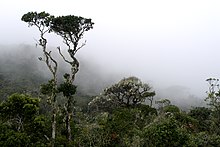
The vegetation of the park is classified into two distinctive groups, 2,000 ha (7.7 sq mi) of wet patna (
Tree trunks and branches are ornamented with many species of ferns, Lycopodium, lichens, and orchids.[6] Old man's beard (Usnea barbata) hanging from branches adds to the beauty of the forests. About 16 of the orchid species are endemic. Other notable plants include shrubs such as Rhodomyrtus tomentosa, Gaultheria fragrantissima, herbs, Exacum trinervium, E. walkeri, Drosera indica, and tree ferns Cyathea spp.[2] Anzia, a foliose lichen genus belonging to the family Parmeliaceae, which had not been recorded in Sri Lanka before, was discovered here in 2007.[3] There are conflicting views on how the grasslands of the park came into being, whether man-made or natural. It is now believed that the grasslands on the dry slopes were created by forest clearance and fires while grasslands in low-lying areas were naturally created by wet conditions, frost and soil erosion.[4]
Fauna
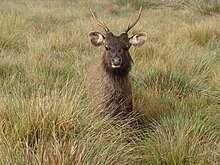
The vertebrate fauna of the region includes 24 species of mammals, 87 species of birds, nine species of reptiles and eight species of amphibians.
In 2016, rusty-spotted cats (Prionailurus rubiginosus) were recorded in Horton Plains National Park for the first time, at altitudes of 2,084–2,162 m (6,837–7,093 ft).[13]
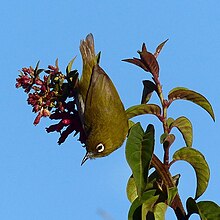
Along with
Sri Lanka is considered a herpetological paradise in the world.
Threats and conservation management

Horton Plains was a part of a large system of plains and forest cover that included Agra-Bopats, Moon Plains and Elk Plains.
Owing to the relatively small size of Horton Plains National Park, it was predicted that most male leopards have activity centres that were outside the park.[19] Hence, continued protection of the national park and integrated management of landscapes outside of the national park is essential for the conservation of the species there.
Some sambar deer have died due to eating polythene litter that blocked their food passages, and visitors are banned from bringing polythene into the park.[20] Sambar have benefited from the introduced Pennisetum grass species.[21]
A recent threat, first reported in 1978, is forest dieback.[4] In some areas, especially in the peripheral region, this has been severe with nearly a 50% in vegetation. Water deficiency has been attributed as the main cause of dieback as droughts are becoming more frequent. The regrowth of forest is hindered by frost which is increasingly severe. The forest dieback has affected 22 species of plants with Calophyllum walkeri being the most affected.[22] A study has suggested that low calcium causes soil acidification and increased toxicity caused by metallic elements such as aluminium may be causing the dieback. Leaching of nutrients and the resulting imbalance in soil micronutrients may also be contributing to the dieback.[23]
Tourist attractions

Horton Plains is a popular tourist destination, with World's End being the key attraction.[2] In the six months ending in August 2009, Horton Plains National Park earned a revenue of Rs. 20.1 million (US$ 0.17 million).[24] The park is accessed by the Nuwara Eliya-Ambewela-Pattipola and Haputale-Boralanda roads, and there are railway stations at Ohiya and Ambewela.
World's End is a sheer precipice with a 870 m (2,854 ft) drop.[6] It is situated at the southern boundary of the park. Another cliff known as the Lesser World's End of 270 m (886 ft) is located not far from World's End.
Baker's Falls, a waterfall formed by Belihul Oya, a tributary of the Walawe River is named after Sir Samuel Baker, a hunter and explorer[25] who attempted to establish a European agricultural settlement at Nuwara Eliya. The waterfall is 20 metres (66 ft) high. Slab Rock Falls is another well-known waterfall in the plains. The waterfall can be reached by walking on one of the main trails; the trail is a bit steep at the end but the difficulty level is medium to easy.[6]
See also
References
- ^ a b "World Heritage Committee inscribes two new sites on World Heritage List". unesco.org. UNESCO. July 30, 2010. Retrieved 1 August 2010.
- ^ a b c d e f g h i j k l "Horton Plains National Park". International Water Management Institute. Archived from the original on August 5, 2010. Retrieved 23 November 2009.
- ^ a b Jayalal, R.G.U.; Wolseley, P.; Pathberiya, L.G.; Wijesundara, D.S.A.; Karunaratne, V. (2007). "Anzia (Lichenized Ascomycetes, Parmeliaceae) A New Record from the Horton Plains National Park, Sri Lanka" (PDF). Proceedings of the Peradeniya University Research Sessions, Sri Lanka. Archived from the original (PDF) on 17 June 2011.
- ^ ISBN 2-8317-0030-2.
- .
- ^ ISBN 978-955-1266-61-5. Archived from the originalon 2011-07-17.
- ^ Vinod Moonesinghe, "OMG! And the Fishers of Ramboda", Ceylon Daily News, 22 June 2012. Archived 19 October 2012 at the Wayback Machine
- .
- ^ Campbell, D. H. (1926). "Ceylon". An outline of plant geography. New York: Macmillan Publishers. p. 191.
- ^ Nekaris, K. A. I. (2007). "Horton Plains Slender Loris, Ceylon Mountain Slender Loris, Loris tardigradus nycticeboides Hill, 1942. In: Primates in Peril: The World's 25 Most Endangered Primates 2006–2008". primate-sg.org. Arlington, VA: Unpublished report, IUCN/SSC Primate Specialist Group (PSG), International Primatological Society (IPS), and Conservation International (CI). pp. 12–13. Archived from the original on 2009-03-28.
- S2CID 8941145. Archived from the original(PDF) on 2009-02-05.
- ^ Hough, A. (19 July 2010). "Horton Plains Slender Loris pictured for first time". The Daily Telegraph. Archived from the original on 21 July 2010. Retrieved 5 August 2010.
- .
- ^ "IBAs in Sri Lanka". birdlife.org. BirdLife International. Retrieved 6 December 2009.
- .
- ^ Lalith Gunasekera, “Alien plants invasion in Horton Plains”, Sri Lanka Guardian, 23.9.2011. Accessed 19.6.2016.
- ^ Milan Lu, ““A growing threat” Archived 2016-08-13 at the Wayback Machine, Ceylon Today, 01.11.2011. Accessed 19.6.2016.
- ^ Ranwala, S.; Marambe, B.; Wijesundara, S.; Silva, P.; Weerakoon, D.; Atapattu, N.; Gunawardena, J.; Manawadu, L. & Gamage, G. (2012). "Post-entry risk assessment of invasive alien flora in Sri Lanka-present status, GAP analysis, and the most troublesome alien invaders". Pakistan Journal of Weed Science Research (Special Issue): 863–871.
- .
- ^ Fernando, V. (2002). "Horton Plains : Nature's pristine glory". Sunday Observer. Archived from the original on 4 January 2010. Retrieved 24 November 2009.
- S2CID 22901926.
- S2CID 189885528.
- S2CID 130388413.
- ^ Sriyananda, Shanika (August 8, 2009). "Wildlife picks up with end of war". Sunday Observer. Archived from the original on 5 September 2009. Retrieved 24 November 2009.
- ^ Baker, SW (1854). The rifle and the hound in Ceylon. Longman, Brown, Green and Longmans, London.
External links
![]() Media related to Horton Plains National Park at Wikimedia Commons
Media related to Horton Plains National Park at Wikimedia Commons

